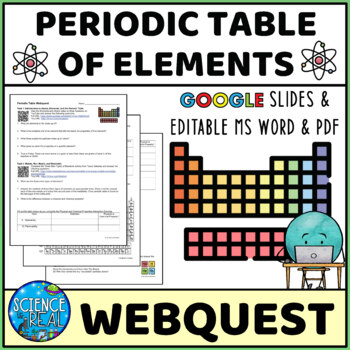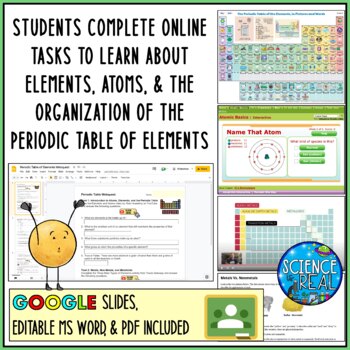Periodic Table Webquest - Editable MS Word, PDF, and Google Slides
- Zip
- Webquests
What educators are saying
Also included in
- ⭐ ⭐ ⭐ ⭐ ⭐ Save over 30% with this growing collection of webquests created for grades 8-12! Save money and time with this Science Webquest Growing Bundle! Get this growing bundle now before more products are added and the price increases! These resources are designed for standard high school or advanPrice $269.73Original Price $385.33Save $115.60
Description
⭐ ⭐ ⭐ ⭐ Editable MS Word, PDF, and Google Slides all included! This periodic table of elements webquest covers the atoms, elements, and the organization of the periodic table. This resource makes a great introduction, review, absent student work, sub-plan, guided practice, or student-led teaching tool. Your students will complete interactive online activities about atoms, elements, and the periodic table of elements. Students will lead their own learning as they complete this editable, printable, and digital webquest. All non-flash modern resources are used - works beautifully on PC, Mac, iPads, Tablets, and most modern cellular devices.
⭐ Topics Include ⭐
• Atoms and Subatomic Particles
• Elements
• Chemical and Physical Properties
• Symbols on the Periodic Table of Elements
• Organization of the Periodic Table of Elements (Groups, Periods)
• Metals, Non-Metals, and Metalloids
Student will follow clear directions to answer chunked questions as they move through the virtual activities. The student handout includes tinyURLs, long URLs, and QR Codes to help students easily reach each virtual activity to immediately begin learning and applying their new knowledge. Your students will have no confusion as they move through the activities and will be on task, having fun, and learning!
Click on the Preview for a closer high-resolution look!
No Adobe Flash is required! Works on all devices. Perfect for distance learning!
⭐ What you will receive:
- Editable Microsoft Word Version (5 Pages)
- PDF Version (Easel Friendly!) 5 Pages
- Google Slides Version
- Answer Key
❤️CLICK TO FOLLOW SCIENCE IS REAL! ❤️
Get Alerted to New Products, Sales, Discounts, and Freebies!
⭐ No Prep and Answer Key is Included!
HAPPY SCIENCING!
⭐ This webquest is included in money saving growing discount webquest bundles!
→ Earth and Space Science Webquests Growing Discount Bundle
→ Biology Webquests Growing Discount Bundle
→ All Science Webquests Discount Growing Bundle
Science Is Real! Terms of Use (TOU):
By purchasing this product, you own a license for one teacher only for personal use in their own classroom. Licenses are non-transferable and therefore cannot be passed from one teacher to another. If the teacher who purchased this license leaves the classroom or changes schools, the license and materials leave with that teacher. No part of this resource is to be shared with colleagues or used by an entire team, grade level, school or district without purchasing the correct number of licenses. If you are a coach, principal or district interested in transferable licenses that would accommodate yearly staff changes, please contact me for a transferable license quote at ajcatts@gmail.com.
Copyright by Science is Real. Please note - all material included in this resource belongs to Ana Catts. By purchasing, you have a license to use the material, but you do not own the material. You may not upload any portion of this resource to the internet in any format, including school/personal websites or network drives unless the site is password protected and can only be accessed by students, not other teachers or anyone else on the internet.
❤️ CHECK OUT MORE GREAT THINGS FROM SCIENCE IS REAL! ❤️
⭐ Balancing Chemical Equations Candy Lab
⭐ Cell Energy 5E Unit Plan - Photosynthesis and Cellular Respiration
⭐ Macromolecules - Biomolecules Growing Bundle
⭐ Macromolecules 5E Unit Plan - Secondary Science
⭐ Macromolecules Assessments - Pre-Test, Post-Test, Question Bank - 100% Editable
⭐ Astronomy Webquests - Growing Bundle
⭐ Biology Webquests Growing Bundle - Google Apps and Standard Files Included






